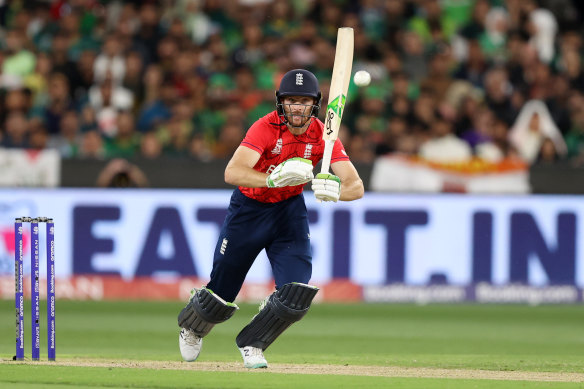- Analysis
- Sport
- Cricket
- ICC Men’s World Cup
This was published 2 years ago
MCG bathed in English blue, but green was colour of the Cup
Icehouse opened a World Cup final night that finished in a blaze of electric blue for England, worthy tournament winners as the best white-ball team of the past five years.
Yet it was green that stood as the colour of this tournament. The verdant tinge of La Nina-proof early season Australian pitches became the defining characteristic of a month of lively and unpredictable cricket, even if it was pockmarked by cloudbursts for the same reason.

Jos Buttler.Credit: Getty Images
T20 had, up to this point, been known largely as a format to be played on flat tracks. Batters were given maximum license and conditional help to attack; bowlers forced to be as resourceful as possible to elude a belting on pitches that offered little help.
To get more equitable conditions was, for the most part, an accident. Certainly, bowlers were preconditioned to feel as such on the rare days when they had a little more than usual to work with.
One Australian bowler, having returned inexpensive figures due to a pitch that suited him earlier this summer, offered words to the effect that in T20 he “shouldn’t be” going for fewer than six runs an over because the format was about entertainment.
And yet the balance of this World Cup has provided so many enriching moments for the fact they have been so evenly spread between batters and bowlers, on a vast array of ground dimensions and surfaces that, if not universally similar, have offered a pleasing mixture of light and shade.
Think back to the SCG shirtfront on which Finn Allen struck the blows for New Zealand that all but eliminated Australia.
That evening had followed a week of sporting surfaces in Hobart and Geelong, and was to be followed by MCG climes that, between showers, allowed India’s Virat Kohli to play a mini-Test match masterpiece against Pakistan and Ireland to wobble the white ball through England.
“The conditions have definitely kept the batsmen humble,” Pakistan’s Shan Masood reflected. “The wickets have been a bit spicy, we saw that today as well, with some rain around.
“There was seam movement even with the older ball, and in these conditions you realise how important it is to put your ego aside, consolidate, build platforms and finish well towards the end. A bit of old-style cricket, but with the bigger boundaries and the quality of the bowling, batsmen were certainly humbled and a lot of people had to change their games to win.”

Sam Curran.Credit: AP
When Australia failed to do enough against Afghanistan to qualify, they were confounded by the vagaries of an Adelaide Oval surface that offered slow seam movement up front before flattening out. When South Africa were spectacularly knocked out by the Netherlands, something like the reverse was true. Ireland’s Josh Little claimed an Adelaide hat-trick there, too.
England’s qualification for the semis was secured against Sri Lanka on an SCG surface that would not have looked out of place in Colombo; their semi-final thrashing of India on perhaps the best batting surface of the tournament.
In the final, the MCG’s pitch was grassy enough to allow Ben Stokes to seam and bounce the ball in the manner of Scott Boland, Sam Curran to winkle out figures of 3-12 at the end of an outstanding tournament for the left-armer, and Adil Rashid to gain spin and bounce in a spell worthy of the Shane Warne Stand from which he delivered it.
Best of all, it created the ideal arena for perhaps the most pulsating passage of play all event: England’s powerplay when chasing Pakistan’s modest target. Pakistan had no option but to attack with the new ball, England no other strategy than to be bold with the bat.
Jos Buttler’s innings contained some exhilarating shots, not least a ramp for six of Naseem Shah. But they came amidst three wickets and gasps from thousands of spectators every time the fast, seaming ball flew past the edge.
“Batters have to think differently, bowlers have been able to attack at certain times,” Buttler said.
“The ball’s swung throughout the tournament, which has added a different dimension. That’s been one of the themes around the tournament. It’s been interesting, it’s thrown up some upsets along the way and different styles of cricket, but we’re delighted to get over the line.”
Perhaps the most maddening element of the finale would later arrive through how, due to a recurrence of the knee problem that had affected him earlier in the year, Shaheen Afridi was unable to provide one last twist of speed.
His courageous, but unsuccessful, effort to return to the bowling crease, with England still needing 41 from the final five overs, was akin to a bell sounding to stop the heavyweight bout before it went the full 40 rounds.
If the scheduling of this World Cup was forced largely by the economics of the Indian Premier League at one end of the Australian season and Cricket Australia’s desire to protect December and January at the other, then it had a pleasing side effect.
That was to recast how we look at T20 and the ideal conditions in which it should be played. On pitches with something for everyone, scattered across this Great Southern Land, we have indeed seen a little bit of everything.
News, results and expert analysis from the weekend of sport sent every Monday. Sign up for our Sport newsletter.